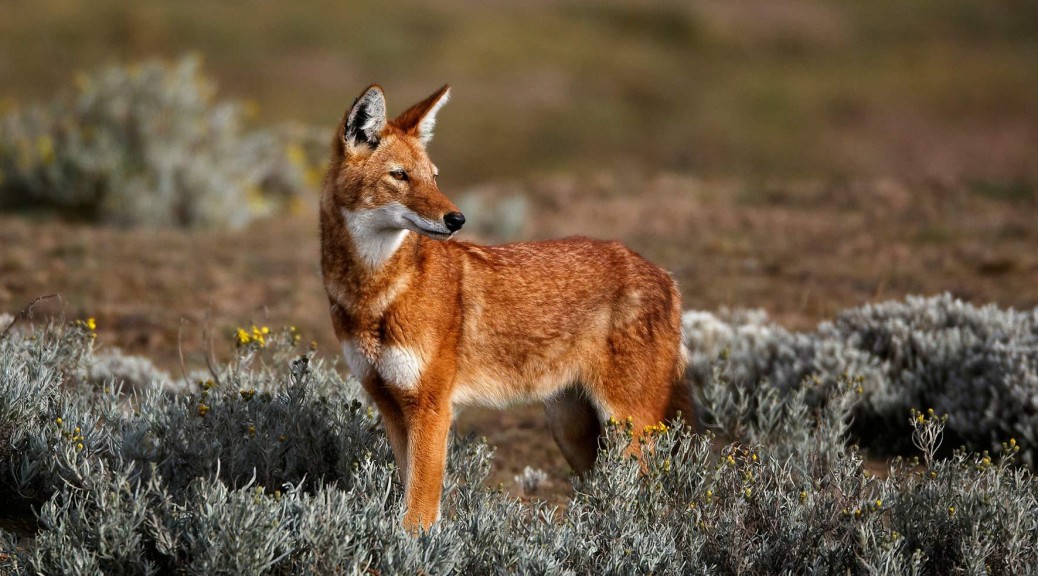Compiling lists starting with “Top 10” or “The Most” are never easy, because no matter what topic you choose, opinions always differ. In compiling this list of Africa’s most endangered animals we have used the IUCN Red List of Threatened Species as a guideline and have stuck to overland safari animals, which means we have excluded various animals including marine species. The animals on the list have been selected due to their status as Endangered or Critically Endangered, which are the highest threat levels before being declared Extinct in the Wild or Extinct. When going through this list, bear in mind that there are thousands of other species under threat, in our oceans and in other parts of the world.
1. Riverine Rabbit
IUCN Status: Critically Endangered
Habitat: Karoo, South Africa
The riverine rabbit is also known as vleihaas, boshaas, doekvoetjie or pondhaas. There are only a few hundred riverine rabbits left in the wild today. It has become endangered due to losing much of its habitat to farming. They are also slow breeders.
2. De Winton’s Golden Mole
IUCN Status: Critically Endangered
Habitat: South Africa
These golden moles were documented a mere 250 years ago, and there is very little knowledge about them. This is mostly because these blind, subterranean mammals have a highly restricted distribution. They are found in remote areas not easily accessible to biologists and their habitat has been affected by diamond mining.
3. Addax
IUCN Status: Critically Endangered
Habitat: Sahara Desert
The addax is also known as the white or screwhorn antelope. They are well-adapted to exist in their desert habitat and can survive without water for long periods of time. However, due to unregulated hunting they are difficult to find in their native habitat.
4. Ethiopian Wolf
IUCN Status: Endangered
Habitat: Ethiopian Highlands
The Ethiopian wolf is a highly specialised feeder of Afroalpine rodents, unlike most large canids, which are widespread, generalist feeders. This wolf has very specific habitat requirements and is the world’s rarest canid, and Africa’s most endangered carnivore. Threats to the species include population fragmentation; habitat loss; encroachment within protected areas; disease; overgrazing; human conflict and hybridisation with dogs.
5. Pygmy Hippopotamus
IUCN Status: Endangered
Habitat: West Africa
The pygmy hippopotamus is one of only two extant species in the Hippopotamidae family, the other being its much larger cousin: the common hippopotamus. The pygmy hippo is a reclusive and nocturnal animal. Pygmy hippos are threatened by habitat loss, as forests are logged and converted to farm land. They are also at risk due to poaching, hunting, natural predators and war.
6. African Wild Dog
IUCN Status: Endangered
Habitat: Southern and East Africa
The African wild dog is also known as the African painted dog. There used to be about 500 000 living in 39 countries. This range included Egypt and parts of the Sahara Desert. Today there are only 3 000 – 5 500 left, living in less than 25 countries. They are an endangered species due to habitat loss, poaching, disease and human conflict on farm land.
7. Black Rhinoceros
IUCN Status: Critically Endangered
Habitat: Central and East Africa
At the beginning of the 20th century, there were several hundred thousand black rhinos living in Africa; but during the second half of the century their numbers were reduced from 70 000 in the late 1960s to less than 15 000 in 1981. Today 2 410 black rhinos remain in the wild. In 2011 the IUCN (International Union for the Conservation of Nature) declared the Western black rhino extinct. Threats to the black rhino include habitat change, war and poaching. Placing black rhinos in captivity makes them more susceptible to disease; problems associated with the minerals they ingest and competition with other herbivorous browsers.
8. Sahafary Sportive Lemur
IUCN Status: Critically Endangered
Habitat: Madagascar
The sahafary sportive lemur lives in trees and is nocturnal. The enlarged, fleshy pads on their hands and feet improve their agility, making it easier for them to move through their environment. They are endangered due to their extremely low population size. They are also hunted, even though it has been declared illegal, and they suffer from habitat loss and fragmentation. They are also at risk as none of the remaining populations occur in protected areas.
9. Greater Bamboo Lemur
IUCN Status: Critically Endangered
Habitat: Madagascar
Habitat loss and degradation is one of the biggest threats facing the greater bamboo lemur. At one stage scientists believed the species to be extinct, but a remnant population was discovered in 1986. Their current range is less than 4{06d929bd3ad4c6a95bf55e898d2636034900819a69887101e766a047db33ac60} of their historic distribution. Most of the former range is no longer suitable due to this lemur’s dietary specialisation on bamboo and its microhabitat preferences. They are further endangered by slash and burn farming, mining, bamboo and other logging and slingshot hunting.
10. Eastern Gorilla
IUCN Status: Endangered
Habitat: Democratic Republic of Congo, Uganda and Rwanda
The eastern gorilla is the largest living primate. It is divided into two subspecies: the eastern lowland gorilla (of which there are about 5 000 individuals) and the mountain gorilla (of which there are about 700 individuals). Although the former are the less threatened of the two gorilla species, they are also the rarer. They are threatened due to hunting for bushmeat and the decline in suitable habitat as a result of increased forestry and agriculture.
